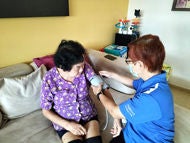What is - Clubfoot
Congenital talipes equinovarus (CTEV), also known as clubfoot, is a congenital condition in which the sole of the foot is turned inwards and backwards. The condition may affect one or both feet.

There are two types of CTEV: postural and structural.
- Postural CTEV involves muscle imbalance and/or tightness. There is usually no bone or joint involvement. In most babies where the clubfoot is postural, the forefoot can be passively moved through a complete range of motion.
- Structural CTEV involves the bone and joints of the foot, where the child's foot cannot be passively put through a full range of motion. The joint deformity appears fixed.
Symptoms of Clubfoot
The condition is often quite obvious after the birth of your child. The physical appearance of the foot may vary.
Signs and symptoms include:
- One or both feet turning inwards
- Tightness in calf muscles
- The calf muscle and affected foot may be slightly smaller than normal
- Decreased joint range of movement in foot (for structural CTEV)
Potential complications of clubfoot include:
- Abnormal walking pattern
- Foot pain due to abnormal foot positions
Clubfoot - How to prevent
As the cause of clubfoot is unknown, there are no proven natural or clinically-approved methods for preventing it.
Clubfoot - Causes and Risk Factors
Causes of clubfoot
- Postural CTEV: May be due to packing disorder (a first-born baby weighing above 4 kg at birth, with decreased fluid surrounding the baby). The deformity may also be due to prolonged positioning in the uterus (womb) and limited mobility, an abnormal uterine shape or a lack of amniotic fluid.
- Structural CTEV: The cause is unknown and in some cases, it may be genetics.
If both feet are affected, the doctor may look for abnormalities at the lower end of your baby’s spine.
Risk factors of clubfoot
Clubfoot is a common congenital condition. One in every 1,000 newborns has clubfoot and the condition is more common in male babies. The risk goes up for babies whose parents or family members have had clubfoot.
Primary risk factors:
- Gender (male)
- Family history
Diagnosis of Clubfoot
Orthopaedic assessments are used to diagnose clubfoot.
Treatment for Clubfoot
Babies with clubfoot are usually referred to a physiotherapist for evaluation and treatment. Treatment consists of joint manipulation as well as strapping with tape to improve joint mobility.
In more severe cases, where joint manipulation and strapping are ineffective, plaster casting and referral to an orthopaedic surgeon may be required.
Below are common treatments for the two types of clubfoot:
- Postural CTEV: Self-resolving. In some cases, physiotherapy intervention for stretching and stimulation to the feet is required.
- Structural CTEV: Serial casting and manipulation with minimal surgery if necessary. In severe cases, surgery may be required. This is followed by maintenance with special boots and bar till four years of age.
Contributed by
The information provided is not intended as medical advice. Terms of use. Information provided by SingHealth.
Condition Treated At
Department
Neonatal and Developmental Medicine
Department
Orthopaedic Surgery
Department
Physiotherapy
Get to know our doctors at SingHealth Hospitals in Singapore.
Get to know our doctors at SingHealth Hospitals in Singapore. here.




















